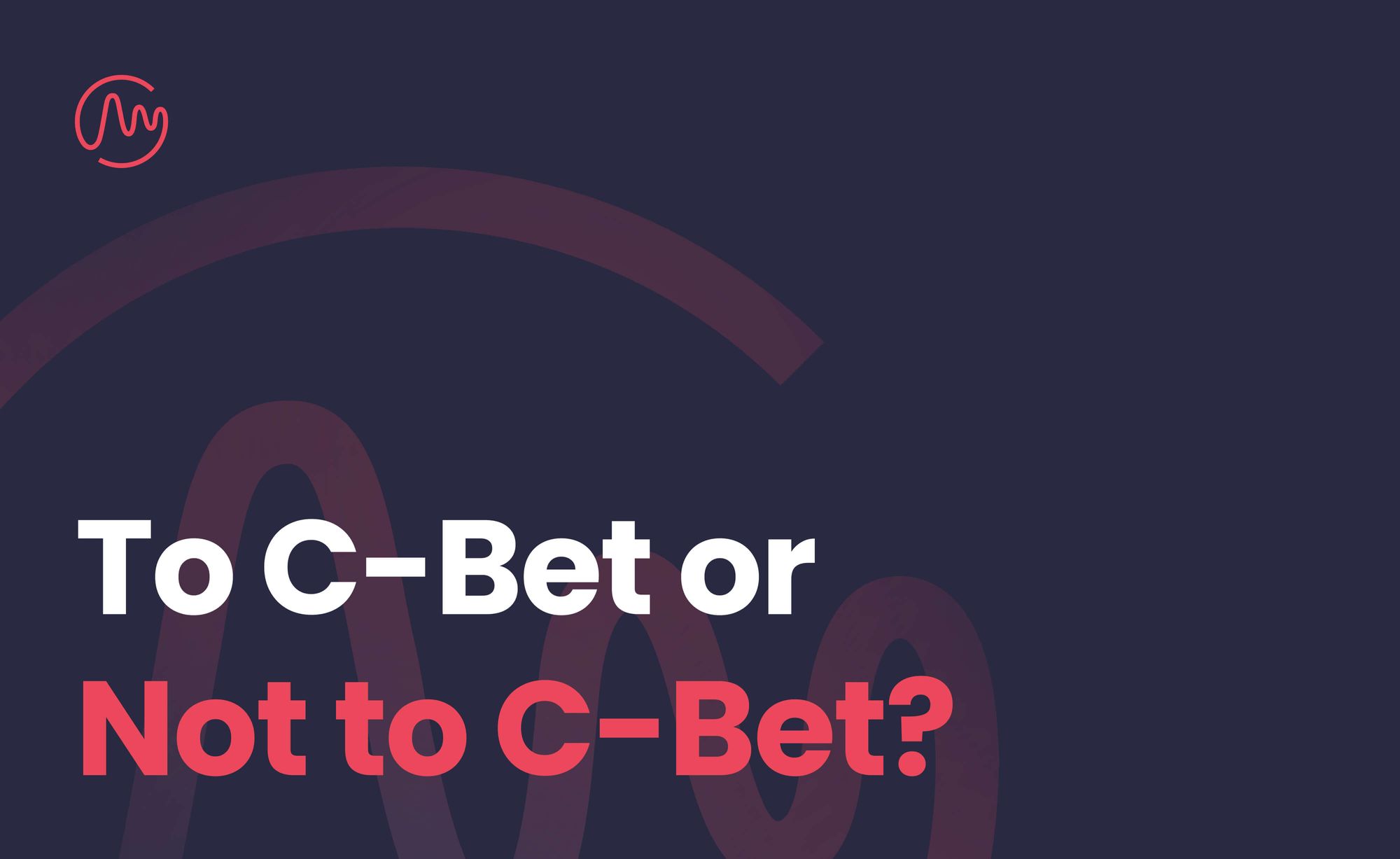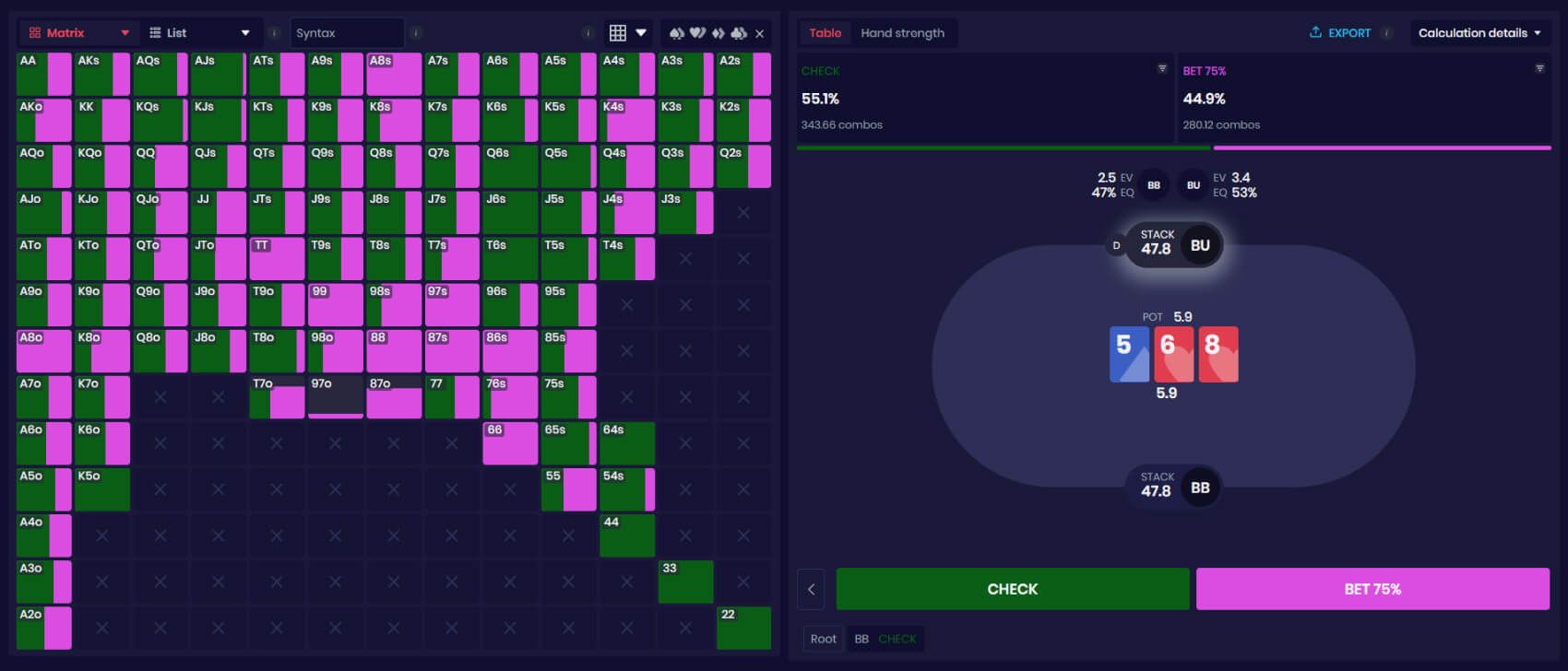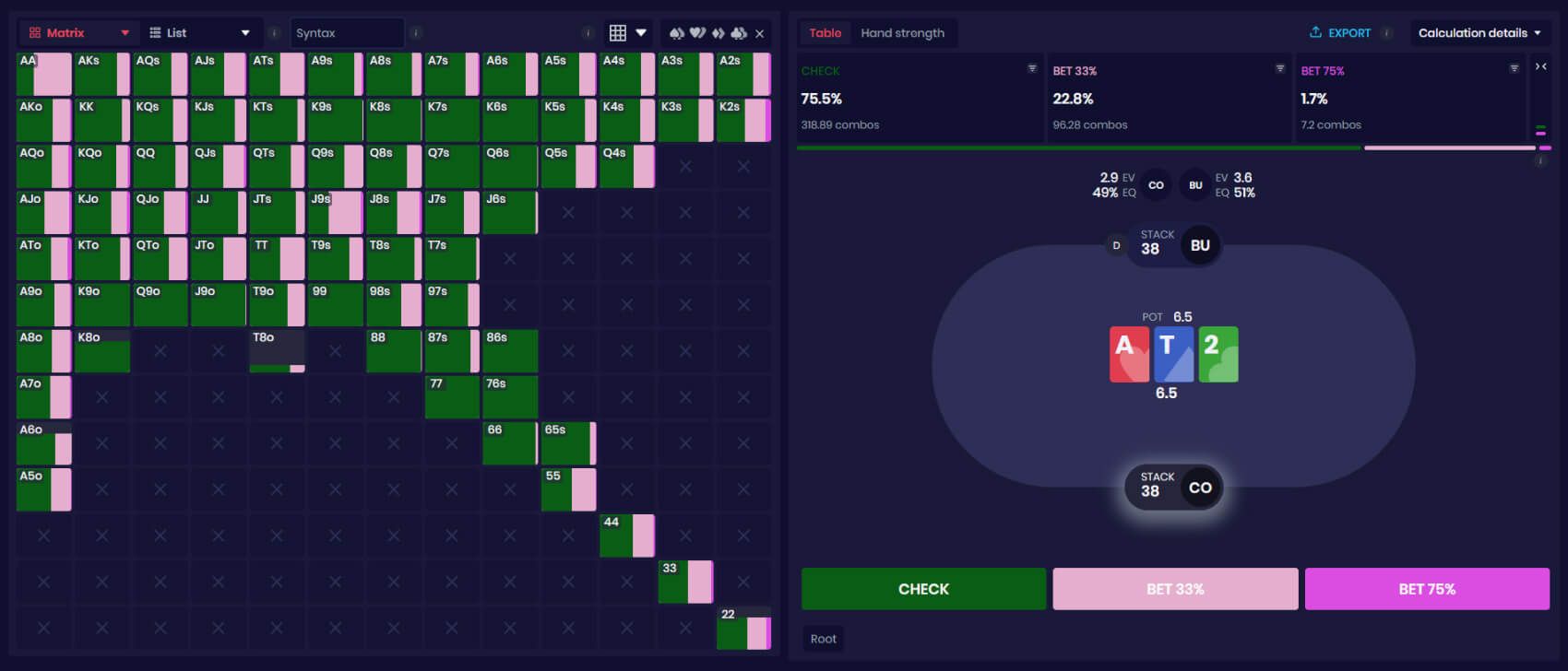Continuation Betting - How to Do It Correctly?
A proper continuation betting strategy? The bread and butter of every potent poker player!

Continuation bet (or c-bet for short) is one of the most common actions you perform at the poker table. Despite its importance, many players do it mindlessly, on autopilot. Since it's one of the most used plays, developing a correct c-betting strategy is crucial. After all, even tiny mistakes repeated often will add up, resulting in a big hit to your overall win rate.
What is considered a continuation bet?
Let's start by clarifying the basics: what conditions must be met for a bet to be considered a continuation bet? Most of the time, the c-bet is a flop bet by a preflop aggressor. If you raise preflop and one or more players call, you place a continuation bet if you are the first person to bet on the flop.
It doesn't matter how many opponents you face or whether they are in or out of position; as long as you are the person who raised preflop, your bet will technically be a continuation bet. At the same time, your flop bet will not be a c-bet if you've limped preflop. Also, if you were the preflop aggressor, but someone bet before your turn to act, you won't be able to c-bet any more.
Most of the time, we'll talk about a c-bet whenever you made a preflop raise and the Big Blind called. In fact, the most common spot in all the poker formats is the heads-up between Button and the Big Blind.
That's why it is one of the best spots to start your study with a poker solver.

Why do we c-bet?
That's a fundamental strategy question, yet many poker players have not thought much about the logic behind c-betting it in-depth.
The basic principle behind any betting is that we bet money (or chips, for that matter) whenever we assume we're more likely to win than to lose. Translating that to poker, players will bet more money on the hands they like and when they believe they can win at the showdown (of course, assuming the poker players we refer to are rational).
So why do we c-bet? Whenever a player raises preflop, they put more money into the pot, suggesting their hand is stronger than the average. If anybody else calls as well, it means they had a chance to put more money into the pot, but they didn't, so the hands of calling players should be weaker than the player raising preflop - at least in theory.
Since around 2/3 of the time, the community cards do not improve the hole cards of any player (assuming heads-up), the preflop aggressor "should" have the stronger hand on the flop; therefore, they continue to bet.

Poker strategy behind the continuation bets
The above explanation is descriptive and suitable to picture the overall idea behind continuation betting, but you should understand two crucial poker strategy terms in this context: range advantage and nut advantage.
Whenever we talk about a particular hand and assess board texture, bet sizing or other circumstances, the most efficient way to come up with a good strategy is to visualize all hands players can have at a certain point of the hand - which we refer to as ranges. Usually, the range of one player is stronger (meaning it has more equity) than the range of the other (or others), which we call a range advantage.
Let's take one of the most common spots as an example: the Button vs the Big Blind, 25 BB deep. Whenever the player on the Button raises on such a stack depth, and the BB player defends, the raising player's range will be stronger on average - meaning it will have more equity. The reason is simple: in such a configuration, BU will have all of the best possible holdings in their range (including all pairs and the best Ax and Kx hands) while the defending player (BB) will lack the best preflop holdings, additionally having a lot of weak hands like high/low combos or low suited cards.
If we compare the equity of the default ranges for that situation, the in-position player will have around 60-40% equity lead in this scenario.

The flop may and will change things
Of course, different flop textures can change the range advantage. Continuing with our example, since the BU player has all of the Ax combos and all the broadways, the flops with high cards will favor them greatly, extending their range advantage.
For example, on the AT9 rainbow flop, the BU player's range advantage will extend to almost 68%. However, on the 765 with a flush draw, BU's advantage will shrink to around 51%.
The second board interacts with the wide Big Blind range much better - the out-of-position player has quite a few straight combos, along with all combos of two pairs (many of which are absent in the BU range).
While the BU player still has a positional advantage and a tiny range advantage, they lost the nut advantage. The nut advantage reflects which player’s range has more combinations of nuts (usually two pairs, sets, straights or better). In the case of the 765 board, the BB player can have almost all of the possible nut combos, while the IP player lacks some straights and two-pair combos.
The concepts of range advantage and nut advantage apply not only on the flop but on every street. These terms are vital to the proper poker strategy, and you should reevaluate them on every street before you decide to bet or check.
Betting is usually a good idea whenever your range maintains a range advantage on the flop. However, you should be more cautious if your opponent has just gained the nuts advantage.

When to c-bet?
Back in the days, when the poker game was more about feeling that solid theory, the answer most poker players would provide would be "Pretty much always". And we can't blame them; a few years ago, the population was so bad at defending versus a 100% continuation bet strategy that you could get away with it.
However, the development of poker tools and poker software, along with the GTO poker studies, broadened our knowledge and drastically changed how we view continuation betting. Nowadays, you have to be smart about it; c-betting mindlessly will work against less aware opponents, but the better ones will start to reraise your continuation bets relentlessly.
With the help of Deepsolver, you can get a clue about what to do and adapt it to your strategy. It'll take some time, as this subject is broad; after all, there are around 19,000 possible combinations of flops. Luckily, we can categorize the flops into groups with similar characteristics, narrowing them to a more manageable number.
For example, the continuation bet strategy will be similar for AK2 and AQ7.
Whenever you think about a continuation bet, you have to consider a few more factors, like your opponent's tendencies or how much folding equity your bet can generate. While those variables will change, the guidelines for a continuation bet or checking will stay the same.
So, which flops are the ones that you should c-bet more often? The ones favouring your range as the preflop aggressor, meaning they improve your range and nut advantage, or at least they do not swing it into your opponent's favour.
Let's assume a heads-up hand the Button versus the Big Blind. Which flops hit the aggressor and extend their range and nut advantage? The most prevalent categories of such flops are high-card heavy, like AK2, AKT or AT2. On all of those flops, your range has all of the nuts combinations, meaning a solid number of your holdings will be value bets (you have all of the sets, two pairs and a lot of top pairs with good kickers; your opponent, on the other hand, will lack the sets, and two pairs most of the time).
The same logic applies to the paired boards as long as the paired card is high, for example, AA2, KKT or QQ5. On such boards, your opponent will have many trips but will be short of the best combos, like AK, AQ, and KQ, because most of these hands have 3-bet preflop, meaning you'll have all the nuts that your opponent will not.
Another category favourable to the preflop raiser is disconnected boards, like T62, J73 or K84, especially without flush draws. Such boards favour the player that raised preflop since their opening range will include a lot of pocket pairs and high cards, which will like to be the best hand postflop, especially versus one opponent.

When not to continue betting?
While generally speaking, it's better to c-bet than not, there are situations (and coordinated boards) which are very tricky to navigate as a preflop raiser, and it will be a major leak to approach them without a plan.
When should you be very cautious about c-betting?
The most prevalent cases will be middle, coordinated boards, like T98, 987 or 765. You'll lack the best nut combos on such flops since you often won't be opening hands like 43, J7, and T6s, meaning your range won't include many straights. On the other hand, your opponent will likely have all of the nuts, and even their weaker hands will often improve to a draw or a pair.
You should apply similar caution when board pairs, but the pair card is medium or low, like 554 or 733. In such cases, your opponent will have many more trips, and your trips will also be limited to the very few combos coming from Ax hands and suited connectors.
Another thing that should deter you from c-betting automatically is whether there is a straight possibility. If the board structure enables straights, the opponent on the Big Blind will likely have the nut advantage (in the form of all possible straights), meaning they can approach such a board aggressively.
Be careful c-betting out of position
What about continuation bets out of position? Here, things got even more tricky. When you c-bet against the Big Blind, the circumstances favour you: your preflop range is stronger, and you will have position during the whole hand. Things change a lot when you play out of position.
Let's say you open from the Middle Position on 40 BB, the Cutoff (covering you) calls your raise, and the rest of the players fold. In such a case, you have to be quite cautious. Let's take the AT2 board texture (which is very good for an aggressor in the BU vs BB scenario), for example. Even though your range should still be more robust, the poker solver suggests betting only 1/4 of the time!
What's the reason? Although your range still has almost all of the possible nuts, the CO range is much stronger in this case than the BB range would be (Cutoff's flatting range is way more Ax-heavy; it also includes less weak hands). The positional advantage will also allow your opponent to realize more of their equity.
While it is only a single example, the principles will be similar, and whenever you play out of position, you'll have to continue betting less frequently.

Multiple opponents equal fewer c-bets
Multiway pots are one of the most complex spots in modern poker. We have quite a good grasp of how to play heads-up poker, but even adding a single opponent makes the game tree drastically more complex. However, assuming you're not a high-stakes regular, the multiway pots (often including several calling stations) are probably your bread and butter, and you must devise a proper strategy.
The concept you should follow is simple; the more players in the pot, the stronger hand you require to c-bet. While a single continuation bet is enough to win a heads-up pot in position quite often, it won't be the case against multiple opponents (especially if at least one of them has a position over you). The best way to adapt, especially on lower stakes, is tedious but practical: tighten up.
Whenever you're in a multiway pot, adopt a tight strategy. Use only your strongest hands and the best semi-bluffs as continuation bets. While such an approach may be far from theory, it is much easier to implement and will save you many tough spots.
What about the continuation bet sizings?
So, now that you know when you should c-bet a lot and when you should be much more selective, let's look at the c-bet sizings. Different players have different approaches, but we believe you shouldn't implement a multi-sizing strategy without a good reason.
In fact, you can use a single bet size strategy most of the time, especially if you are not yet aiming for high stakes. The key concepts to understand are whether you should c-bet in the first place and which bet sizing is most suitable for your range.

A good c-betting strategy is a must for a solid poker player
If you want to move up the stakes, you must accurately assess when to c-bet and when not. Luckily, with the help of modern poker tools, it's easier than ever.
In this article, we've only highlighted the most important aspects of continuation betting, but it's a great starting point for your own studies. With the help of Deepsolver, learning how to act in the most common spots will be easier than you think.
And if you hit a dead end, our community is here to help. Join our Discord server and discover how our community makes the most of Deepsolver!